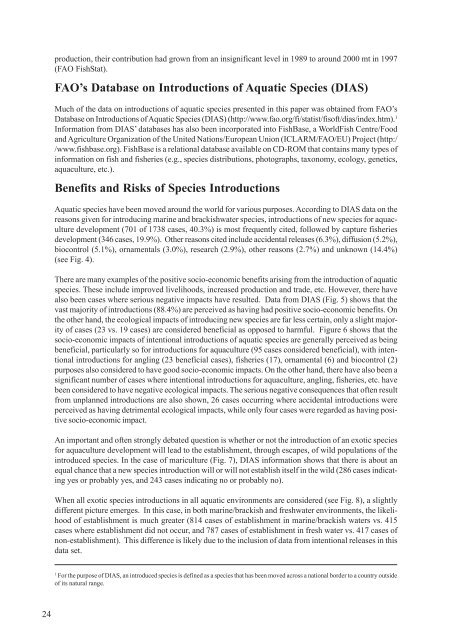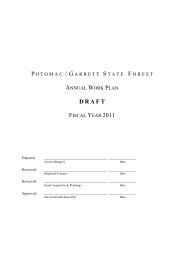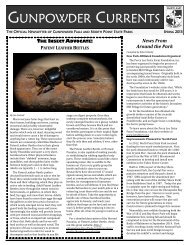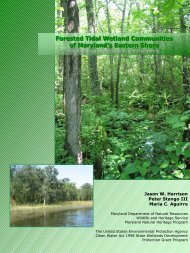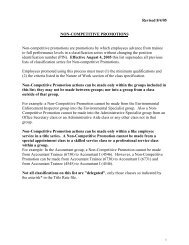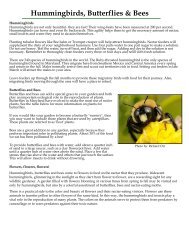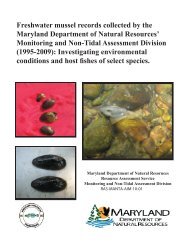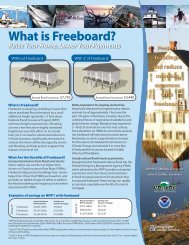NAca Section 2.pmd - Maryland Department of Natural Resources
NAca Section 2.pmd - Maryland Department of Natural Resources
NAca Section 2.pmd - Maryland Department of Natural Resources
You also want an ePaper? Increase the reach of your titles
YUMPU automatically turns print PDFs into web optimized ePapers that Google loves.
24<br />
production, their contribution had grown from an insignificant level in 1989 to around 2000 mt in 1997<br />
(FAO FishStat).<br />
FAO’s Database on Introductions <strong>of</strong> Aquatic Species (DIAS)<br />
Much <strong>of</strong> the data on introductions <strong>of</strong> aquatic species presented in this paper was obtained from FAO’s<br />
Database on Introductions <strong>of</strong> Aquatic Species (DIAS) (http://www.fao.org/fi/statist/fis<strong>of</strong>t/dias/index.htm). 1<br />
Information from DIAS’ databases has also been incorporated into FishBase, a WorldFish Centre/Food<br />
and Agriculture Organization <strong>of</strong> the United Nations/European Union (ICLARM/FAO/EU) Project (http:/<br />
/www.fishbase.org). FishBase is a relational database available on CD-ROM that contains many types <strong>of</strong><br />
information on fish and fisheries (e.g., species distributions, photographs, taxonomy, ecology, genetics,<br />
aquaculture, etc.).<br />
Benefits and Risks <strong>of</strong> Species Introductions<br />
Aquatic species have been moved around the world for various purposes. According to DIAS data on the<br />
reasons given for introducing marine and brackishwater species, introductions <strong>of</strong> new species for aquaculture<br />
development (701 <strong>of</strong> 1738 cases, 40.3%) is most frequently cited, followed by capture fisheries<br />
development (346 cases, 19.9%). Other reasons cited include accidental releases (6.3%), diffusion (5.2%),<br />
biocontrol (5.1%), ornamentals (3.0%), research (2.9%), other reasons (2.7%) and unknown (14.4%)<br />
(see Fig. 4).<br />
There are many examples <strong>of</strong> the positive socio-economic benefits arising from the introduction <strong>of</strong> aquatic<br />
species. These include improved livelihoods, increased production and trade, etc. However, there have<br />
also been cases where serious negative impacts have resulted. Data from DIAS (Fig. 5) shows that the<br />
vast majority <strong>of</strong> introductions (88.4%) are perceived as having had positive socio-economic benefits. On<br />
the other hand, the ecological impacts <strong>of</strong> introducing new species are far less certain, only a slight majority<br />
<strong>of</strong> cases (23 vs. 19 cases) are considered beneficial as opposed to harmful. Figure 6 shows that the<br />
socio-economic impacts <strong>of</strong> intentional introductions <strong>of</strong> aquatic species are generally perceived as being<br />
beneficial, particularly so for introductions for aquaculture (95 cases considered beneficial), with intentional<br />
introductions for angling (23 beneficial cases), fisheries (17), ornamental (6) and biocontrol (2)<br />
purposes also considered to have good socio-economic impacts. On the other hand, there have also been a<br />
significant number <strong>of</strong> cases where intentional introductions for aquaculture, angling, fisheries, etc. have<br />
been considered to have negative ecological impacts. The serious negative consequences that <strong>of</strong>ten result<br />
from unplanned introductions are also shown, 26 cases occurring where accidental introductions were<br />
perceived as having detrimental ecological impacts, while only four cases were regarded as having positive<br />
socio-economic impact.<br />
An important and <strong>of</strong>ten strongly debated question is whether or not the introduction <strong>of</strong> an exotic species<br />
for aquaculture development will lead to the establishment, through escapes, <strong>of</strong> wild populations <strong>of</strong> the<br />
introduced species. In the case <strong>of</strong> mariculture (Fig. 7), DIAS information shows that there is about an<br />
equal chance that a new species introduction will or will not establish itself in the wild (286 cases indicating<br />
yes or probably yes, and 243 cases indicating no or probably no).<br />
When all exotic species introductions in all aquatic environments are considered (see Fig. 8), a slightly<br />
different picture emerges. In this case, in both marine/brackish and freshwater environments, the likelihood<br />
<strong>of</strong> establishment is much greater (814 cases <strong>of</strong> establishment in marine/brackish waters vs. 415<br />
cases where establishment did not occur, and 787 cases <strong>of</strong> establishment in fresh water vs. 417 cases <strong>of</strong><br />
non-establishment). This difference is likely due to the inclusion <strong>of</strong> data from intentional releases in this<br />
data set.<br />
1 For the purpose <strong>of</strong> DIAS, an introduced species is defined as a species that has been moved across a national border to a country outside<br />
<strong>of</strong> its natural range.


